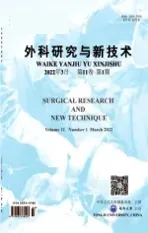Posterior articular process approach for the treatment of upper lumbar disc herniation
2011-08-15项良碧XiangLiangbiDeptOrthopGenHospShenyangMilCommandShengyang110016ChinClinBasicOrthopRes2010204207
项良碧(Xiang Liangbi,Dept Orthop,Gen Hosp Shenyang Mil Command,Shengyang 110016)…∥Chin J Clin Basic Orthop Res.-2010,2(3).-204~207
Posterior articular process approach for the treatment of upper lumbar disc herniation
项良碧(Xiang Liangbi,Dept Orthop,Gen Hosp Shenyang Mil Command,Shengyang 110016)…∥Chin J Clin Basic Orthop Res.-2010,2(3).-204~207
ObjectiveTo investigate the feasibility and surgical effects of posterior articular process approach for the treatment of L1-L3 lumbar disc herniation.MethodsA retrospective study,of 17 patients with upper lumbar intervertebml disc herniation was carried out,m which 13 patients were treated with unilateral articular process excision and nucleus pulposus resection,lumbar interbody fusion and pedicle screw internal fixation while 4 patients were treated with bilateral articular process excision and nucleus pulposus resection,lumbar interbody fusion and pedicle screw internal fixation.ResultsAll patients had an average follow-up period of 14 months(12-16 months).Preoperative Oswestry dysfunction index(ODD was(88.1 4 ± 5.8)%and postoperative ODI was(47.9 ±4.9)%respectively,which showed significant improvement(t=14.754,P=0.003);According to Japanese Orthopaedic Association(JOA)scores,the total excellent-to-good rate was 94.1%(16/17).No injuries of spinal cord,nerve root and blood vessels occurred during the operation,and X-ray showed that all cases had bone graft fusion without internal fixation failure.ConclusionOperation through posterior articular process approach is a feasible surgical method for upper lumbar disc herniation with the advantages of minimal invasion,less complications and satisfactory clinical effects.9 refs,1 fig.
(Authors)
杂志排行
外科研究与新技术的其它文章
- Treatment for 63 cases of the elderly with choledocholith by duodenoscope
- Clinical features and surgical treatment of the coexistence of cervical,thoracic and lumber degen-erativ diss
- Free-hand cervical pedicle screw fixation for upper cervical fracture and instability
- Atlantoaxial pedicle screw system for treatment of unstable atlantoaxial dislocation post traction
- The application of C1-C2 pedicle screw internal fixation on the upper cervical diseases of chil-dren
- One stage anterior release and posterior fusion for the treatment of irreducible atlantoaxial dislocation secondary to os odontoideum
